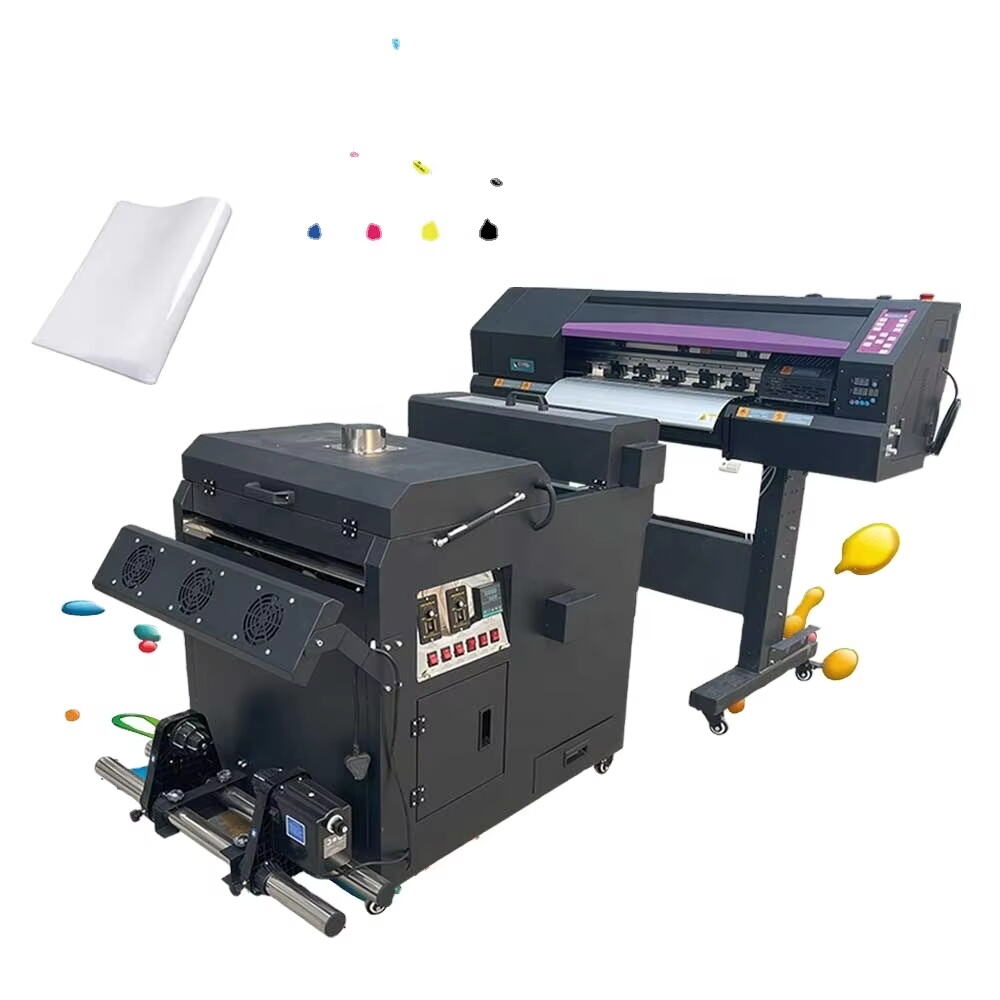What Are Thermal Transfer Machines?
Thermal transfer machines are remarkable devices that harness heat and pressure to transfer intricate designs onto a variety of substrates. Central to their operation is the utilization of heat-sensitive inks and special transfer papers that react under controlled conditions. This technology ensures that designs are permanently affixed to surfaces, offering durability and vibrancy. Integral to the printing industry, these machines play a prominent role in producing custom designs for apparel, promotional materials, and personal items. They have significantly streamlined the creation process, enabling designers to bring unique concepts to life with precision and ease.
The market for thermal transfer technology has witnessed substantial growth, propelled by its widespread adoption among small businesses and hobbyists alike. According to industry studies, the global market size is projected to reach $23 billion by 2026, driven by increasing demand for personalized products. This burgeoning interest underscores the versatility and efficiency of thermal transfer machines as key tools in the printing sector. As more creative entrepreneurs explore custom printing, these machines emerge as invaluable assets, simplifying production processes and expanding creative possibilities.
Types of Thermal Transfer Machines
Flat Press Machines for Garments
Flat press machines are essential tools in garment printing, designed to efficiently utilize a heat transfer process to apply designs to clothing. These machines use a large heated platen and pressure settings to ensure that designs are evenly transferred onto various materials, including cotton, polyester, and fabric blends, making them highly versatile for fabric printing. Their capability to handle a variety of textures and thicknesses means they are suitable for personalizing everything from T-shirts to sweatshirts and more.
The demand for flat press machines continues to rise, supported by positive user reviews and expert recommendations for brands like Stahls' and Hotronix. As more businesses and hobbyists venture into custom garment production, these machines are favored for their reliability and flexibility, making them an indispensable asset in the custom apparel market.
Mug Press Machines for Drinkware
Mug press machines specialize in transferring designs onto cylindrical surfaces such as mugs and tumblers, employing heat and pressure to ensure a smooth, durable finish. The technology works by wrapping a heat transfer material around the drinkware and pressing it with a contoured heating element designed to hug the mug’s shape. This is especially advantageous for businesses focusing on custom drinkware, allowing for a range of personalized products from coffee mugs to insulated bottles.
With the trend of personalized drinkware on the rise, mug press machines have seen a marked increase in demand. According to industry reports, the market for custom drinkware is expanding annually, driven by both consumer interest in unique, personalized items and the marketing needs of businesses.
Cap Press Machines for Headwear
Cap press machines offer a specialized method for imprinting logos and designs on headwear, operating differently from other heat press machines due to their unique heat application and compatibility with various fabrics. These machines are designed with a curved heating element that fits snugly over the cap, applying even pressure and heat to ensure the design adheres flawlessly without damage to the material.
In terms of applications, cap press machines are widely used across sectors such as sports, corporate branding, and promotional events. Small businesses and event organizers benefit significantly from these machines as they allow for the efficient production of high-quality custom merchandise. Users often report enhanced brand recognition and loyalty as major benefits of incorporating custom headwear into their marketing strategies. Testimonials from small event producers highlight the machines' efficiency and quality in delivering professional-looking products.
Key Factors to Consider When Selecting a Thermal Transfer Machine
Heat Plate Size and Compatibility
The size of the heat plate in a thermal transfer machine is crucial as it directly impacts the scale and efficiency of operations. A larger heat plate can accommodate bigger projects, allowing for more significant single processes and saving time in batch processing. Choosing a heat plate that accommodates various substrate sizes enhances production versatility, allowing businesses to cater to diverse printing needs. Data from industry case studies show that businesses have significantly improved output by selecting appropriate heat plate sizes, fostering scalability and efficiency. This choice allows them to meet broader customer demands and enhances production versatility.
Temperature Range and Precision Control
A thermal transfer machine's temperature range and precision control are pivotal for ensuring the quality of the final product. Precise temperature settings help in adjusting the heat according to the material, which is crucial for achieving a seamless transfer. Industry standards indicate that optimal temperature settings vary across different materials, with expert opinions suggesting specific ranges for fabrics like polyester or metals. Statistics show that machines offering advanced temperature regulation features have higher user satisfaction and enhanced performance, demonstrating the importance of precision control in thermal transfer operations.
Pressure Adjustment Mechanisms
Effective pressure adjustment mechanisms are vital for achieving high-quality transfers, especially on uneven surfaces. Different mechanisms cater to varying needs, ensuring that designs are transferred evenly and resisting issues such as peeling or fading. Adequate pressure contributes significantly to the quality of the transfer, with user testimonials consistently highlighting satisfaction linked to effective pressure settings. Customer feedback ratings often correlate with machines that provide precise pressure adjustments, emphasizing the importance of such features in ensuring the longevity and clarity of the transferred designs.
Balancing Cost vs. Functionality
Budget-Friendly Options for Startups
Selecting budget-friendly thermal transfer machines can significantly benefit startups, as they allow businesses to kickstart their operations without overwhelming initial investments. These machines typically range in price from $200 to $600, offering essential features like consistent heat distribution and reliable temperature control. It's important for startups to select machines that accommodate low-volume production while ensuring quality outputs for small batches. Startups such as a small craft shop or a local apparel brand have successfully launched with budget models and scaled their operations over time, effectively balancing cost and quality.
Mid-Range Machines for Growing Businesses
For businesses that are past their startup phase and are on the path to growth, mid-range thermal transfer machines might be the ideal choice. These machines offer a perfect balance of cost and functionality, making them suitable for businesses looking to enhance their production volumes or expand their range of services. Features such as larger heat plates, improved precision in temperature controls, and programmable settings provide great advantages. Case studies reveal that businesses upgrading to mid-range options often experience significant improvements in efficiency and product output, allowing them to meet higher market demands more effectively.
Industrial-Grade Equipment for High-Volume Needs
When it comes to high-volume production, industrial-grade thermal transfer machines stand out due to their robustness and high output capacity. These machines are built to handle large-scale operations with enhanced durability and performance efficiency. Industrial models may require a significant initial investment, but they offer long-term cost-effectiveness due to their capability to manage heavy-duty applications consistently. Industry statistics suggest a high return on investment for businesses with large output needs, showcasing how transitioning to industrial-grade equipment can support and accelerate expansive business growth.
Common Mistakes to Avoid When Choosing a Thermal Transfer Machine
Overlooking Material Compatibility Requirements
Material compatibility is a crucial factor in the thermal transfer process that can significantly affect product quality. Choosing the wrong material for a particular machine can result in subpar finishes and reduced durability of printed items. For instance, some thermal transfer machines work best with certain types of label stock, while others might be incompatible with heat-sensitive materials. A user shared their experience online, highlighting a situation where using polypropylene labels with a machine not designed for this material led to poor adhesion and color quality. Therefore, it is critical to test compatibility before committing to a purchase to ensure the best output without compromising quality.
Sacrificing Safety Features for Lower Costs
Safety features in thermal transfer machines are indispensable and should never be compromised for the sake of cost. Machines with inadequate safety features may pose risks such as overheating, electrical hazards, or mechanical failures. It is essential to consider safety standards, such as CE or UL certifications, when selecting a machine. These features not only protect users but also extend the operational life of the device. A report from a manufacturing unit cited incidents where opting for cheaper models with substandard safety features led to operator injuries and costly legal issues. Hence, investing in well-designed safety features ensures a reliable and safer working environment in the long term.
Ignoring Maintenance and Replacement Part Availability
Neglecting maintenance and the accessibility of replacement parts can lead to prolonged downtime and increased costs in thermal transfer operations. Machines that are not regularly maintained or those lacking readily available parts can suffer from breakdowns that halt production. It is vital to select machines for which parts are easy to source and replace. Expert opinions often highlight businesses that faced significant operational hindrances due to the unavailability of critical components, underscoring the need for proper maintenance and planning for future part replacements. Consequently, understanding the maintenance requirements and ensuring part availability are key considerations for sustaining the longevity and efficiency of thermal transfer machines.
Conclusion: Summary of Tips for Selecting the Right Thermal Transfer Machine
To ensure you choose the best thermal transfer machine for your business or personal use, there are essential tips to keep in mind. Firstly, always assess material compatibility carefully since certain materials may not interact well with specific machine types, leading to inferior output quality. Secondly, prioritize models with robust safety features over cost-cutting options, thereby ensuring the welfare of operators and machinery longevity. Thirdly, examine the maintenance requirements and availability of replacement parts, as these factors will influence the machine's usability and lifespan. Keep these fundamentals in mind to make an informed decision.
FAQ
What is a thermal transfer machine used for?
Thermal transfer machines are used to transfer designs onto various substrates like garments, mugs, and caps by using heat and pressure. They are commonly used in custom printing industries.
Which industries benefit most from thermal transfer machines?
Industries such as fashion, promotional products, sports, and home-based businesses benefit most from thermal transfer machines due to their versatility in customizing a wide range of products.
How do I choose the right thermal transfer machine for my business?
Consider the machine's material compatibility, safety features, maintenance requirements, heat plate size, temperature range, and pressure adjustment mechanisms when choosing the right thermal transfer machine for your needs.
Are industrial-grade thermal transfer machines worth the investment?
Yes, industrial-grade machines are worth the investment for businesses with high-volume needs due to their robustness and capability to manage large operations efficiently.
What are common mistakes to avoid when selecting a thermal transfer machine?
Common mistakes include overlooking material compatibility, sacrificing safety features for cost, and ignoring maintenance and replacement part availability.
Table of Contents
- What Are Thermal Transfer Machines?
- Types of Thermal Transfer Machines
- Key Factors to Consider When Selecting a Thermal Transfer Machine
- Balancing Cost vs. Functionality
- Common Mistakes to Avoid When Choosing a Thermal Transfer Machine
- Conclusion: Summary of Tips for Selecting the Right Thermal Transfer Machine
-
FAQ
- What is a thermal transfer machine used for?
- Which industries benefit most from thermal transfer machines?
- How do I choose the right thermal transfer machine for my business?
- Are industrial-grade thermal transfer machines worth the investment?
- What are common mistakes to avoid when selecting a thermal transfer machine?

